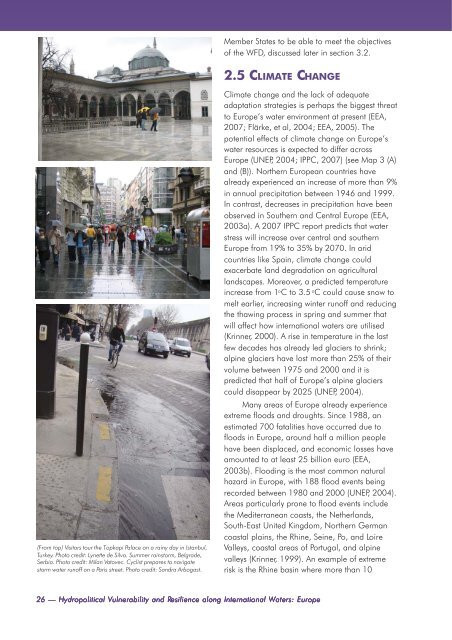Europe - UNEP
Europe - UNEP
Europe - UNEP
Create successful ePaper yourself
Turn your PDF publications into a flip-book with our unique Google optimized e-Paper software.
Member States to be able to meet the objectives<br />
of the WFD, discussed later in section 3.2.<br />
2.5 CLIMATE CHANGE<br />
(From top) Visitors tour the Topkapi Palace on a rainy day in Istanbul,<br />
Turkey. Photo credit: Lynette de Silva. Summer rainstorm, Belgrade,<br />
Serbia. Photo credit: Milan Vatovec. Cyclist prepares to navigate<br />
storm water runoff on a Paris street. Photo credit: Sandra Arbogast.<br />
Climate change and the lack of adequate<br />
adaptation strategies is perhaps the biggest threat<br />
to <strong>Europe</strong>’s water environment at present (EEA,<br />
2007; Flärke, et al, 2004; EEA, 2005). The<br />
potential effects of climate change on <strong>Europe</strong>’s<br />
water resources is expected to differ across<br />
<strong>Europe</strong> (<strong>UNEP</strong>, 2004; IPPC, 2007) (see Map 3 (A)<br />
and (B)). Northern <strong>Europe</strong>an countries have<br />
already experienced an increase of more than 9%<br />
in annual precipitation between 1946 and 1999.<br />
In contrast, decreases in precipitation have been<br />
observed in Southern and Central <strong>Europe</strong> (EEA,<br />
2003a). A 2007 IPPC report predicts that water<br />
stress will increase over central and southern<br />
<strong>Europe</strong> from 19% to 35% by 2070. In arid<br />
countries like Spain, climate change could<br />
exacerbate land degradation on agricultural<br />
landscapes. Moreover, a predicted temperature<br />
increase from 1 o C to 3.5 o C could cause snow to<br />
melt earlier, increasing winter runoff and reducing<br />
the thawing process in spring and summer that<br />
will affect how international waters are utilised<br />
(Krinner, 2000). A rise in temperature in the last<br />
few decades has already led glaciers to shrink;<br />
alpine glaciers have lost more than 25% of their<br />
volume between 1975 and 2000 and it is<br />
predicted that half of <strong>Europe</strong>’s alpine glaciers<br />
could disappear by 2025 (<strong>UNEP</strong>, 2004).<br />
Many areas of <strong>Europe</strong> already experience<br />
extreme floods and droughts. Since 1988, an<br />
estimated 700 fatalities have occurred due to<br />
floods in <strong>Europe</strong>, around half a million people<br />
have been displaced, and economic losses have<br />
amounted to at least 25 billion euro (EEA,<br />
2003b). Flooding is the most common natural<br />
hazard in <strong>Europe</strong>, with 188 flood events being<br />
recorded between 1980 and 2000 (<strong>UNEP</strong>, 2004).<br />
Areas particularly prone to flood events include<br />
the Mediterranean coasts, the Netherlands,<br />
South-East United Kingdom, Northern German<br />
coastal plains, the Rhine, Seine, Po, and Loire<br />
Valleys, coastal areas of Portugal, and alpine<br />
valleys (Krinner, 1999). An example of extreme<br />
risk is the Rhine basin where more than 10<br />
26 — Hydropolitical Vulnerability and Resilience along International Waters: <strong>Europe</strong>
















